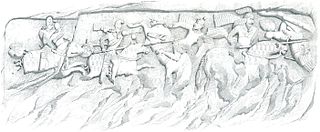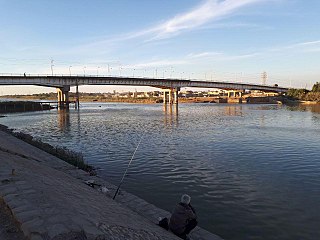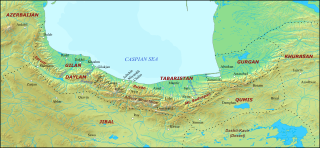History
According to the two Persian historians Hamza Isfahani and Ibn al-Faqih, Vahman-Ardashir was constructed (or re-built) by the first king of the Sasanian Empire, Ardashir I (r. 224–242), while some other sources such as al-Tabari, gives the legendary Iranian king Kay Bahman credit for the foundation of the town. However, mention of this town first appears in 544, when the Nestorian bishop of Vahman-Ardashir is appointed as the metropolitan of Meshan. According to Ibn Khordadbeh, Vahman-Ardashir, along with Meshan (a sub-district named after the province), Dastimeshan, and Abar-Kavadh, formed the four sub-districts of a district named Shad Bahman (also spelled Vahman), which also known as "the Tigris district". An estuary named Bahmanshir, is known to be derived from the name of Vahman-Ardashir.
In 635, during the Muslim conquest of Persia, Vahman-Ardashir was seized by the Arab military officer Utbah ibn Ghazwan. The town would later be involved in revolts by the Zanj in 689–690, 695, and during the height of the power of the Zanj, known as the Zanj Rebellion, which lasted from 869 to 883. During the 13th-century, Vahman-Ardashir was destroyed.

Hormizd-Ardashir, better known by his dynastic name of Hormizd I, was the third Sasanian King of Kings (shahanshah) of Iran, who ruled from May 270 to June 271. He was the third-born son of Shapur I, under whom he was governor-king of Armenia, and also took part in his father's wars against the Roman Empire. Hormizd I's brief time as ruler of Iran was largely uneventful. He built the city of Hormizd-Ardashir, which remains a major city today in Iran. He promoted the Zoroastrian priest Kartir to the rank of chief priest (mowbed) and gave the Manichaean prophet Mani permission to continue his preaching.

Hormizd II was king (shah) of the Sasanian Empire. He ruled for seven years and five months, from 303 to 309. He was a son and successor of Narseh.

Shapur I was the second Sasanian King of Kings of Iran. The precise dating of his reign is disputed, but it is generally agreed that he ruled from 240 to 270, with his father Ardashir I as co-regent until the death of the latter in 242. During his co-regency, he helped his father with the conquest and destruction of the Arab city of Hatra, whose fall was facilitated, according to Islamic tradition, by the actions of his future wife al-Nadirah. Shapur also consolidated and expanded the empire of Ardashir I, waged war against the Roman Empire, and seized its cities of Nisibis and Carrhae while he was advancing as far as Roman Syria. Although he was defeated at the Battle of Resaena in 243 by Roman emperor Gordian III, he was the following year able to win the Battle of Misiche and force the new Roman emperor Philip the Arab to sign a favorable peace treaty that was regarded by the Romans as "a most shameful treaty".

Ardashir III was the Sasanian King of Kings of Iran from 6 September 628 to 27 April 630.

Ardashir II, was the Sasanian King of Kings of Iran from 379 to 383. He was the brother of his predecessor, Shapur II, under whom he had served as vassal king of Adiabene, where he fought alongside his brother against the Romans. Ardashir II was appointed as his brother's successor to rule interimly till the latter's son Shapur III reached adulthood. Ardashir II's short reign was largely uneventful, with the Sasanians unsuccessfully trying to maintain rule over Armenia.

Firuzabad is a city in the Central District of Firuzabad County, Fars province, Iran, serving as both capital of the district and of the county. Firuzabad is south of Shiraz. The city is surrounded by a mud wall and ditch.

Artabanus IV, also known as Ardavan IV (Parthian:𐭓𐭕𐭐𐭍), incorrectly known in older scholarship as Artabanus V, was the last ruler of the Parthian Empire from c. 213 to 224. He was the younger son of Vologases V, who died in 208.

Istakhr was an ancient city in Fars province, five kilometres north of Persepolis in southwestern Iran. It flourished as the capital of the Persian Frataraka governors and Kings of Persis from the third century BC to the early 3rd century AD. It reached its apex under the Sasanian Empire, and was the hometown of the Sasanian dynasty. Istakhr briefly served as the first capital of the Sasanian Empire from 224 to 226 AD and then as principal city, region, and religious centre of the Sasanian province of Pars.

Mazun was a Sasanian province in Late Antiquity, which corresponded to modern-day Bahrain, Qatar, United Arab Emirates, and the northern half of Oman. The province served as a Sasanian outpost and played an important role in the Sasanian efforts to gain control over the Indian Ocean trade, and to establish their dominance in the wealthy regions of Hadramaut and Yemen.

Ardashir-Khwarrah was one of the four administrative divisions of the Sasanian province of Pars. The other administrative divisions were Shapur-Khwarrah, Istakhr and Darabgerd, while a fifth named Arrajan was founded in the early 6th century by Kavadh I.

The Battle of Hormozdgan was the climactic battle between the Arsacid and the Sasanian dynasties that took place on April 28, 224. The Sasanian victory broke the power of the Parthian dynasty, effectively ending almost five centuries of Parthian rule in Iran, and marking the official start of the Sasanian era.

Meshan was a province of the Sasanian Empire. It consisted of the Parthian vassal kingdom of Characene and reached north along the Shatt al-Arab river and then the lower Tigris to Madhar and possibly further. Its inhabitants included Babylonians, Arabs, Iranians, and even some Indians and Malays. The province was very fertile, the best place for barley according to Strabo, and contained many date palms. It was also an important trading province along the Persian Gulf.

Ganzak, is an ancient town founded in northwestern Iran. The city stood somewhere south of Lake Urmia, and it has been postulated that the Persian nobleman Atropates chose the city as his capital. The exact location, according to Minorsky, Schippmann, and Boyce, is identified as being the ruins at Leylan, Malekan County in the Miandoab plain.

The Bahmanshir channel is a secondary estuary of the Karun River that parallels the Shatt al-Arab/Arvand Rud waterway on the far side of the Abadan Island, Iran, for 70 miles before emptying into the Persian Gulf.

Veh-Ardashir, was an ancient Sasanian city in present-day Iraq, and formed a suburb of their capital, Ctesiphon.
Abar-Kavad, known in Arabic sources as Abarqubadh and Abazqubadh, was a sub-district in the Sasanian province of Meshan.

Pars was a Sasanian province in Late Antiquity, which almost corresponded to the present-day province of Fars. The province bordered Khuzestan in the west, Kirman in the east, Spahan in the north, and Mazun in the south.

Kirman was a Sasanian province in Late Antiquity, which almost corresponded to the present-day province of Kerman. The province bordered Pars in the west, Abarshahr and Sakastan in the northeast, Paradan in the east, Spahan in the north, and Mazun in the south. The capital of the province was Shiragan.

The Kings of Persis, also known as the Darayanids, were a series of Persian kings, who ruled the region of Persis in southwestern Iran, from the 2nd century BCE to 224 CE. They ruled as sub-kings of the Parthian Empire, until they toppled them and established the Sasanian Empire. They effectively formed some Persian dynastic continuity between the Achaemenid Empire and the Sasanian Empire.

Ruyan, later known as Rustamdar (رستمدار), was the name of a mountainous district that encompassed the western part of Tabaristan/Mazandaran, a region on the Caspian coast of northern Iran.

















